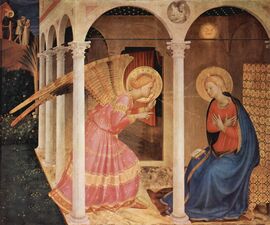السلام عليك يا مريم
صلاة السلام عليك او السلام الملكي او السلام الملائكي[1][2] هي صلاة مسيحية عريقة مستخدمة في الكنيسة الكاثوليكية والأرثودوكسية لتمجيد مريم العذراء أم يسوع (أم الله الابن).The prayer is based on two biblical passages featured in the Gospel of Luke: the Angel Gabriel's visit to Mary (the Annunciation) and Mary's subsequent visit to Elisabeth, the mother of John the Baptist (the Visitation). It is also called the Angelical Salutation, as the prayer is based on the Archangel Gabriel's words to Mary.[3] The Hail Mary is a prayer of praise for and of petition to Mary, regarded as the Theotokos (Mother of God). Since the 16th century, the version of the prayer used in the Catholic Church closes with an appeal for her intercession. The prayer takes different forms in various traditions and has often been set to music.
In the Latin Church, the Hail Mary forms the basis of other prayers such as the Angelus and the Rosary. In the psalmody of the Oriental Orthodox Churches a daily Theotokion is devoted to ascribing praise to the Mother of God.[4] In addition, the Eastern Orthodox Churches have a common private prayer quite similar to the Hail Mary, though without the explicit request for intercession. The Eastern Catholic Churches follow their respective traditions or adopt the Latin Church version, which is also used by many other Western groups historically branching from the Catholic Church, such as Lutherans, Anglicans, Independent Catholics, and Old Catholics.[5]
الصلاة الحالية بالعربية
السلام عليك يا مريم
يا ممتلئة نعمة الرب معك
مباركة انتِ في النساء ومباركة ثمرة بطنك يسوع
يا مريم القديسة يا والدة الله
صلّي لاجلنا نحن الخطأة
الآن وفي ساعة موتنا .
الصلاة بالدارجة المغربية
سلام عليك يا مريم
ياللي عامرة بنعمة, سيدي ربي معاك
مباركة نتيا ف لعيالات ومباركة تمرت كرشك يسوع
يالالة مريم لمقدسة يا ماين الله
دعي لينا حنا المودنيبين
دابا وف ساعة الموت ديالنا
الصلاة الاصلية في اللاتينية
Ave Maria, gratia plena Dominus tecum;
Benedicta tu in mulieribus,
et benedictus fructus ventris tui, Jesus.
Sancta Maria, Mater Dei ora pro nobis peccatoribus,
nunc et in hora mortis nostrae.
تاريخ الصلاة
يستمد الجزء الاول من الصلاة من الانجيل كما في التالي:
- لوقا 1:28
28 فَدَخَلَ الْمَلاَكُ وَقَالَ لَهَا: «سَلاَمٌ، أَيَّتُهَا الْمُنْعَمُ عَلَيْهَا! الرَّبُّ مَعَكِ: مُبَارَكَةٌ أَنْتِ بَيْنَ النِّسَاءِ».
- لوقا 1:42
42 وَهَتَفَتْ بِصَوْتٍ عَالٍ قَائِلَةٍ: «مُبَارَكَةٌ أَنْتِ بَيْنَ النِّسَاءِ! وَمُبَارَكَةٌ ثَمَرَةُ بَطْنِكِ!
أما الجزء الثاني فقد تم اضافته من قبل الكنيسة لطلب المعونة من العذراء .
See also
Notes
References
- ^ "CATHOLIC ENCYCLOPEDIA: Hail Mary". www.newadvent.org. Retrieved 23 فبراير 2023.
- ^ "Hail Mary | Prayer, History, & Uses | Britannica". www.britannica.com (in الإنجليزية). Retrieved 23 فبراير 2023.
- ^ Schmitt, Jacob (1894). Explanation of Deharbe's small catechism: by James Schmitt. Transl. from the 7th German ed. [Josef Deharbe SJ] (in الإنجليزية). Herder. p. 289. Retrieved 23 فبراير 2023.
- ^ Claremont Coptic Encyclopedia: Hail Mary
- ^ Johnson, Maxwell E. (2015). The Church in Act: Lutheran Liturgical Theology in Ecumenical Conversation (in الإنجليزية). Fortress Press. ISBN 978-1-4514-9668-0.
وصلات خارجية
- University of Dayton Hail Mary in various languages
- Audio recordings and texts of the Hail Mary and other prayers in various languages
- Article 2, "THE WAY OF PRAYER", 2676–2677, on the Hail Mary—Catechism of the Catholic Church
- "The Village of St. Bernadette" at YouTube, video of Andy Williams' performance of a song using "Ave Maria" as its refrain.



